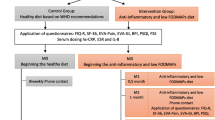Abstract
Fibromyalgia (FM) is a common disease that results in poor quality of life, causing widespread musculoskeletal pain and stiffness, fatigue, sleep disorders, and cognitive impairment among other symptoms. The lack of an effective treatment makes necessary a multidimensional management. FM patients usually seek, from different sources, information about possible benefits from foods, nutrients, or diets. Our objective was to investigate the dietary awareness, food allergies and/or intolerances (FAIs), and nutritional supplement (NS) consumption of FM patients. A questionnaire was prepared with six questions regarding dietary habits, FAIs, and NS use. The questionnaire was filled out by patients recruited in local fibromyalgia associations. One hundred and one women were suffering from FM, diagnosed for more than 6 months, mean age of 53.88 ± 7.78 years; 30% of them changed their diet because of their disease, trying to improve it, and most of them were also using some NS; 7% of women in this group had FAIs, a figure slightly higher than the FAI prevalence in the general population (2–5%) and positively associated with consumption of supplements. Among NS users, some differences were observed; past NS users currently consume a wider range of products, more than new NS users. Magnesium was one of the supplements most recommended specifically for FM. Seventy-four percentage of these patients used NS following advice from health professionals. Once patients are diagnosed, they change their dietary habits and nutritional supplement intake, seeking nutritional strategies to improve their symptoms. Health professionals’ advice plays a relevant role.
Similar content being viewed by others
References
Salaffi F, Sarzi-Puttini P, Girolimetti R, Atzeni F, Gasparini S, Grassi W (2009) Health-related quality of life in fibromyalgia patients: a comparison with rheumatoid arthritis patients and the general population using the SF-36 health survey. Clin Exp Rheumatol 27(5 Suppl 56):S67–74
Rehm SE, Koroschetz J, Gockel U, Brosz M, Freynhagen R, Tölle TR, Baron R (2010) A cross-sectional survey of 3,035 patients with fibromyalgia: subgroups of patients with typical comorbidities and sensory symptom profiles. Rheumatol (Oxford) 49(6):1146–1152
Calande EP, García-Carrillo J, García-Leiva JM, Rico-Villademoros F, Molina-Barea R, Rodríguez-López CM (2010) Subgrouping patients with fibromyalgia according to the results of the fibromyalgia impact questionnaire: a replication study. Rheumatol Int. doi:10.1007/s00296-010-1521-3
Verra ML, Angst F, Brioschi R, Lehmann S, Keefe FJ, Staal JB, de Bie RA, Aeschlimann A (2009) Does classification of persons with fibromyalgia into multidimensional pain inventory subgroups detect differences in outcome after a standard chronic pain management program? Pain Res Manag 14(6):445–453
Wilson HD, Starz TW, Robinson JP, Turk DC (2009) Heterogeneity within the fibromyalgia population: theoretical implications of variable tender point severity ratings. J Rheumatol 36(12):2795–2801
Carville S, Arendt-Nielsen S, Bliddal H et al (2008) EULAR evidence-based recommendations for the management of fibromyalgia syndrome. Ann Rheum Dis 67(4):536
Arranz LI, Canela MA, Rafecas M (2010) Fibromyalgia and nutrition, what do we know? Rheumatol Int 30(11):1417–1427
Yunus MB, Arslan S, Aldag JC (2002) Relationship between body mass index and fibromyalgia features. Scand J Rheumatol 31(1):27–31
Neumann L, Lerner E, Glazer Y, Bolotin A, Shefer A, Buskila D (2008) A cross-sectional study of the relationship between body mass index and clinical characteristics, tenderness measures, quality of life, and physical functioning in fibromyalgia patients. Clin Rheumatol 27(12):1543–1547
Bennett RM, Jones J, Turk DC, Russell IJ, Matallana L (2007) An internet survey of 2, 596 people with fibromyalgia. BMC Musculoskelet Disord 8:27
Okifuji A, Bradshaw DH, Olson C (2009) Evaluating obesity in fibromyalgia: neuroendocrine biomarkers, symptoms, and functions. Clin Rheumatol 28(4):475–478
Wallace DJ, Hallegua DS (2004) Fibromyalgia: the gastrointestinal link. Curr Pain Headache Rep 8(5):364–368
Bellanti JA, Sabra A, Castro HJ, Chavez JR, Malka-Rais J, de Inocencio JM. (2005) Are attention deficit hyperactivity disorder and chronic fatigue syndrome allergy related? What is fibromyalgia? Allergy Asthma Proc Jan-Feb;26(1):19–28
Chang L (1998) The association of functional gastrointestinal disorders and fibromyalgia. Eur J Surg 164:32–36
North CS, Hong BA, Alpers DH (2007) Relationship of functional gastrointestinal disorders and psychiatric disorders: implications for treatment. World J Gastroenterol 13(14):2020
Erdogan S, Gurer G, Afsin H, Kucukzeybek Y (2011) Evaluation of gastric emptying rate in patients with fibromyalgia: a case control study. Mod Rheumatol 21(2):174–177
Madsen C (1997) Prevalence of food allergy/intolerance in Europe. Environ Toxicol Pharmacol 4(1–2):163–167
Schäfer T, Böhler E, Ruhdorfer S, Weigl L, Wessner D, Heinrich J, Filipiak B, Wichmann H (2001) Epidemiology of food allergy/food intolerance in adults: associations with other manifestations of atopy. Allergy 56(12):1172–1179
Zuberbier T, Edenharter G, Worm M, Ehlers I, Reimann S, Hantke T, Roehr CC, Bergmann KE, Niggemann B (2004) Prevalence of adverse reactions to food in Germany–a population study. Allergy 59(3):338–345
Madsen C (2005) Prevalence of food allergy: an overview. Proc Nutr Soc 64:413–417
Zimmerman GL, Olsen CG, Bosworth MF (2000) ‘Stages of change’ approach to helping patients change behavior. Am Fam Physician 61:1409–1416
Worsley A (2002) Nutrition knowledge and food consumption: can nutrition knowledge change food behaviour? Asia Pac J Clin Nutr 11(Suppl):S579–S585
Haugen M, Kjeldsen-Kragh J, Nordvåg B, Førre Ø (1991) Diet and disease symptoms in rheumatic diseases—Results of a questionnaire based survey. Clin Rheumatol 10(4):401–407
Ortolani C (1999) Controversial aspects of adverse reactions to food. Allergy 54(1):27–45
Holton KF, Kindler LL, Jones KD (2009) Potential dietary links to central sensitization in fibromyalgia: past reports and future directions. Rheum Dis Clin N Am 35(2):409–420
Stata Corp (2009) Stata Users Guide Release 11. Stata Press, College Station
Acknowledgments
This research received no specific grant from any funding agency in the public, commercial, or not-for-profit sectors. We are very grateful to Rebecca Jeffree for her help in the linguistic revision of the text.
Conflict of interest
There is no conflict of interests.
Author information
Authors and Affiliations
Corresponding author
Rights and permissions
About this article
Cite this article
Arranz, LI., Canela, MÁ. & Rafecas, M. Dietary aspects in fibromyalgia patients: results of a survey on food awareness, allergies, and nutritional supplementation. Rheumatol Int 32, 2615–2621 (2012). https://doi.org/10.1007/s00296-011-2010-z
Received:
Accepted:
Published:
Issue Date:
DOI: https://doi.org/10.1007/s00296-011-2010-z




